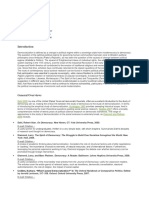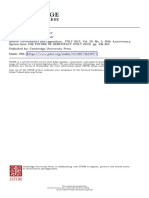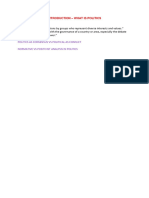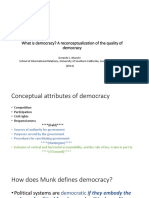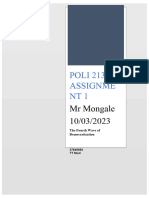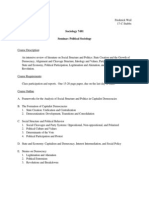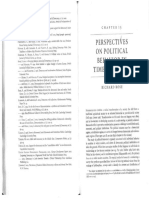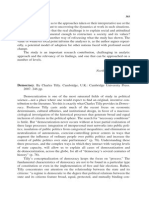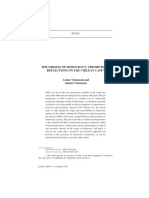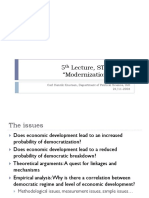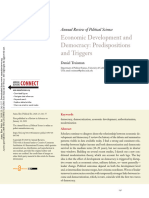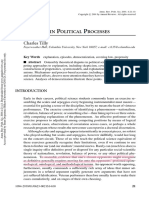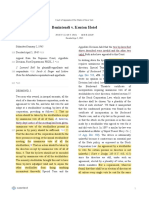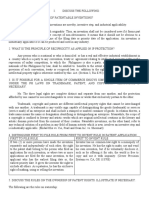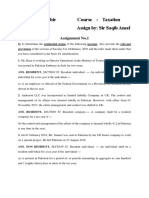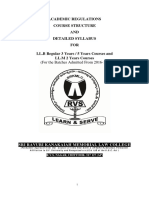Processes and Mechanisms of Democratization
Uploaded by
Alim Somethin WateverProcesses and Mechanisms of Democratization
Uploaded by
Alim Somethin WateverProcesses and Mechanisms of Democratization
Author(s): Charles Tilly
Source: Sociological Theory, Vol. 18, No. 1 (Mar., 2000), pp. 1-16
Published by: American Sociological Association
Stable URL: http://www.jstor.org/stable/223279 .
Accessed: 31/01/2014 12:52
Your use of the JSTOR archive indicates your acceptance of the Terms & Conditions of Use, available at .
http://www.jstor.org/page/info/about/policies/terms.jsp
.
JSTOR is a not-for-profit service that helps scholars, researchers, and students discover, use, and build upon a wide range of
content in a trusted digital archive. We use information technology and tools to increase productivity and facilitate new forms
of scholarship. For more information about JSTOR, please contact support@jstor.org.
American Sociological Association is collaborating with JSTOR to digitize, preserve and extend access to
Sociological Theory.
http://www.jstor.org
This content downloaded from 66.77.17.54 on Fri, 31 Jan 2014 12:52:36 PM
All use subject to JSTOR Terms and Conditions
Processes and Mechanisms of Democratization*
CHARLES TILLY
Columbia University
UnlikeArtistotle'sanalysis, recenttreatmentsof democratizationidentifypathways and
propose necessary conditions butfall short of specifying cause-effect relations. Democ-
ratization does notfollow a single path, and is unlikely to have universally applicable
necessary or sufficientconditions.A political process analysis of democratizationdefines
it as movement toward broad citizenship, equal citizenship, binding consultation of
citizens, and protection of citizensfrom arbitrary state action. High levels of all four
elements depend on a significant degree of state capacity. Democratization emerges
from interacting changes in public politics, categorical inequality, and networks of
trust, which in turn depend on specifiable mechanisms of change in social relations.
Whenthe shocksof conquest,confrontation,colonization,and revolutionpromotedemoc-
ratization, they do so by accelerating the same causal mechanisms. The next roundof
research and theory on democratizationrequires identification, verification, and con-
nection of the relevant causal mechanisms.
Aristotle described democratizationas a perversion (Barnes 1984). In a constitutional
government,when the majoritysubstitutedits particularinterestfor the community'sgen-
eral interest, self-serving rule of the many-democracy-resulted. In his analysis of polit-
ical forms, Aristotle went on to specify processes promoting a majority's pursuit of its
narrow interest, for example the rise of demagogues and the increase of a polity's size
beyond the limits of mutualacquaintance.He also allowed thatrevolution could convert a
tyranny or an oligarchy (his names for degenerate forms of monarchy and aristocracy)
directly into a democracy.Aristotle's Politics does not offer a causal theory sufficient to
specify the process by which today's Uganda or Uzbekistan could become democratic.It
does, however, provide an exemplary model of theoreticallycoherentexplanation.It goes
far beyond mappingthe initial conditions and sequences of events that constitute paths to
democracy.It actually features causes and effects.
Explicitly identified causes and effects, in contrast, rarely grace recent discussions of
democratization.Instead,analysts of democratizationfavor path-tracing.No doubt detect-
ing a path's existence makes a crucial move toward learning how to walk it. But even an
excellent map does not teach plodding urbaniteshow to climb mountains.A commendably
earnest search for visibly viable paths to democracy has skewed recent investigations
away from causes to necessary and sufficient conditions. By now we have a plethora of
conditions that someone has found to be associated with the onset of democracy, and
precious little idea of causal processes that generate such associations.
As a preliminaryeffort, to be sure, a search for conditions under which democratic
polities emerge (or, for that matter,disappear)forwardsthe explanationand productionof
democratization.It helps specify exactly what investigatorsmust explain. If, for example,
*Under NSF grant SBR 9601236, the Center for Advanced Study in the Behavioral Sciences supported this
paper'sinitial draftingand discussion. An earlierversion circulatedas a workingpaperin ColumbiaInternational
Affairs Online (CIAO), 1999. For criticism, information,and encouragement,I am gratefulto RonaldAminzade,
Jack Goldstone, Ira Katznelson, Jane Mansbridge, Sidney Tarrow,Edward Tiryakian,KatherineVerdery,Bin
Wong, Viviana Zelizer, and members of the social science seminar,Center for InternationalSecurity and Arms
Control, StanfordUniversity, none of whom bears the blame for my arguments.
Sociological Theory 18:1 March 2000
? American Sociological Association. 1307 New YorkAvenue NW, Washington,DC 20005-4701
This content downloaded from 66.77.17.54 on Fri, 31 Jan 2014 12:52:36 PM
All use subject to JSTOR Terms and Conditions
2 SOCIOLOGICALTHEORY
democratizationalways occurs in the companyof widening splits within ruling oligarchies
(that is, such splits are active candidates for necessary conditions of democratization),a
valid causal story will most likely connect democratizationwith such splits. Search for
closely associated conditions also rules out many bad explanationssimply by showing that
they are incompatiblewith existing cases; if, for example, a population'sgeneralized trust
often rises from very low to very high after democratizationbegins, then previously exist-
ing high levels of generalized trust lose credibility as general causes of democratization.
Specifying what must be explained and ruling out bad explanations contribute signifi-
cantly to any explanatoryinquiry.But they do not in themselves constitute explanations.
What does? Explanation requires identification of recurrentcausal mechanisms that
democratize a polity, plus specification of conditions that affect emergence and concat-
enation of those mechanisms. This article grows out of an effort to specify the various
conditions and processes that promoted or blocked democratizationin different parts of
Europe between 1650 and the present. It identifies possible mechanisms in democratiza-
tion, then specifies likely conditions affecting their emergence and concatenation.It works
its way backwardthroughthe broad causal sequence schematized in Figure 1. Read for-
ward, the diagramsays that:
* a varietyof changes,herebundledtogetheras "regimeenvironment,"activatemech-
anisms that in turn generate incrementalalterationsin public politics, inequality,
and networks of trust;
* changes of inequality and of trust networks have independenteffects on public
politics;
* regime environmentalso producesoccasional shocks in the form of conquest, con-
frontation,colonization, or revolution;
* such shocks accelerate the standardchange mechanisms, thus causing relatively
rapid alterationsof public politics, inequality,and networks of trust;
* whether incrementalor abrupt,those alterationsinteract;
* under rare but specifiable conditions those alterationsproduce democratization;
and
* democratizationis a special condition of public politics.
The point of this article is to unpack, clarify, and make plausible such an argument.
The argumentproceeds on six fundamentalassumptions:(1) if democratizationoccurs,
the process does not take place on the scale of millennia (with the implication that it can
only happen in places that have accumulateda favorable environmentvery gradually)or
on the scale of months(with the implicationthatcanny social engineers can build it rapidly
almost anywhere), but at a scale in between, most likely over years or decades; (2) pre-
vailing circumstancesunder which democratizationoccurs vary significantly from era to
era and region to region as a function of the internationalenvironment,available models of
political organization,and predominantpatternsof social relations; (3) not just one, but
multiple paths to democracyexist; (4) most large-scale social environmentsthat have ever
existed and the majorityof those that exist today contain major obstacles to democracy;
(5) yet such obstacles diminish rapidlyunderspecifiable circumstances;and (6) democra-
tization has rarelyoccurred,and still occurs rarely,because undermost political regimes in
most social environmentsmajorpolitical actorshave strongincentives and means to block
the very processes that promote democratization.
This content downloaded from 66.77.17.54 on Fri, 31 Jan 2014 12:52:36 PM
All use subject to JSTOR Terms and Conditions
PROCESSESAND MECHANISMSOF DEMOCRATIZATION 3
SHOCK: CONQUEST,
4-
CONFRONTATION,
COLONIZATION,OR REVOLUTION REGIME
ENVIRONMENT
CHANGE MECHANISMS
V
U.
s/
NETWORKS
.4- - t- - - - - . OF
TRUST
4!
DEMOCRATIZATION
Figure 1. Causal Sequences in Democratization
If all six of these assumptionshold, attemptsto specify universallyapplicablenecessary
and/or sufficient conditions for democratizationwill invariablyfail. In that case, our best
alternativeis to look for widely applicabledemocracy-promotingcausal mechanisms,then
to identify variable conditions for their emergence and concatenation. In this view, any
explanationof democratizationmust include a serious account of mechanisms that reduce
the standardobstacles. Ironically, a successful version of such an inquiry could plausibly
produce a single prescriptive model for intervention to promote democratization,thus
This content downloaded from 66.77.17.54 on Fri, 31 Jan 2014 12:52:36 PM
All use subject to JSTOR Terms and Conditions
4 SOCIOLOGICALTHEORY
fostering the illusion of a single pathto democracy,a unique set of necessary and sufficient
conditions. It could do so either because in the present social environmentone of many
historically possible causal paths is much more feasible and attractivethan the others or
because once-viable conditions for all the others have now disappeared.Few of us will
choose to reenact long, violent struggles against tyranny or oligarchy if gentler paths to
democracy have opened.
Warning:we are now embarkingnot on a fact-finding mission but on a conceptual and
theoreticalexcursion. This article presents neitherprecise hypotheses nor evidence for its
arguments.It does not review the vast recent literatureon democratization,nor does it
attemptto synthesize argumentsor findings in that literature.It makes rash declarations
without qualificationor illustration.It draws on insights gained in my own effort to make
sense of democratizationon those rareoccasions when it occurredover the last four cen-
turies of Europeanhistory. It sketches a way of thinking about democratizationand states
the case for a different explanatorystrategyfrom the one most recent students of democ-
racy and democratizationhave employed.
How will we know democratizationwhen we see it? Workingdefinitions of democracy
divide into three overlapping categories: substantive criteria emphasizing qualities of
human experience and social relations; constitutional criteria emphasizing legal proce-
dures such as elections and referenda;and political-process criteria emphasizing inter-
actions among politically constituted actors (for recent reviews and critiques, see Collier
and Levitsky 1997; Dawisha 1997). Substantive definitions have the inconvenience of
leaving deeply contested whether any concrete regime actually qualifies as democratic,
and if so for whom. Constitutionaldefinitions have the inconvenience of raising questions
about discrepancies between official rules and their practical enforcement. Political-
process definitions have the dual inconveniences of unfamiliarityand complexity, hence
of greaterdistance from the everyday discourse of politicians and citizens.
Shoulderingthe inconveniences, my own preferreddefinition falls squarelywithin the
political-process category. For present purposes, a regime is democratic insofar as it
maintains broad citizenship, equal citizenship, binding consultation of citizens at large
with respect to governmental activities and personnel, as well as protection of citizens
from arbitrary action by governmental agents. I prefer such a political-process defini-
tion on the groundsthat (a) it capturesmuch of what theoristsof democracyfromAristotle
onwardhave been trying to describe without the usual inconveniences of substantiveand
constitutionaldefinitions, (b) it clarifies causal connections between popularstruggle and
democratization,a much misunderstoodbut crucial relationship,and (c) it locates democ-
racy within a causally coherent and more general field of variationin characteristicsand
practices of regimes.
Let me excavate the political-process definition of democracy to expose its founda-
tions. Regimes, as schematized in Figure 2, consist of governmentsand their relations to
populationsfalling undertheirclaimedjurisdictions(Finer 1997). Singling out constituted
collective political actors (those thathave names, internalorganization,and repeatedinter-
actions with each other), we can distinguish agents of government, polity members
(constitutedpolitical actors enjoying routine access to governmentagents and resources),
challengers (constituted political actors lacking that routine access), subjects (persons
and groups not currentlyorganizedinto constitutedpolitical actors), and outside political
actors, including othergovernments.Public politics consists of claim-makinginteractions
among agents, polity members, challengers, and outside political actors.
Regimes vary, among other ways, in breadth (the proportionof all persons underthe
government'sjurisdiction that belong to polity members), equality (the extent to which
persons who do belong to polity membershave similar access to governmentalagents and
This content downloaded from 66.77.17.54 on Fri, 31 Jan 2014 12:52:36 PM
All use subject to JSTOR Terms and Conditions
PROCESSES AND MECHANISMS OF DEMOCRATIZATION 5
",---71 J
\ Rulerand
Outside f--------- \ Government
Actor
* Polity
, ^~f
^7~"~" polity
Limitsof
Govemment's
Jurisdiction
Ju\idct Outside of Polity
^ -------------------.
Coalitions
Figure 2. A Static Regime Model
resources), consultation (the degree to which polity members exercise binding collective
control over governmental agents, resources, and activities), and finally protection (shield-
ing of polity members and their constituencies from arbitrary action by governmental
agents). Breadth, equality, consultation, and protection change in partial independence of
each other; authoritarian populist regimes, for example, have commonly created relatively
broad and equal polity membership in combination with limited consultation and little
protection. To simplify matters, nevertheless, we can combine breadth, equality, consul-
tation, and protection into a bundle of variables we call protected consultation. (Readers
who prefer numerical formulations can think of it this way: we standardize our assess-
ments of breadth, equality, consultation, and protection on the full range of historical
experience in each regard, assigning 0 to the lowest value ever observed and 1 to the
highest value, then multiply the four ratings into a single score that will likewise vary from
0 to 1.) When protected consultation reaches high levels (say 0.8 on our combined scale),
we begin to speak of democracy. Strictly speaking, then, democratization is not a conse-
quence of changes in public politics but a special kind of alteration in public politics.
Figure 1 represents public politics and democratization as two separate boxes simply to
stress the causal problem at hand: what produces those alterations of public politics that
increase protected consultation?
If democracy entails high levels of protected consultation by definition, as a practical
matter it also requires the institution of citizenship. Citizenship consists, in this context, of
mutual rights and obligations binding governmental agents to whole categories of people
who are subject to the government's authority, those categories being defined chiefly or
This content downloaded from 66.77.17.54 on Fri, 31 Jan 2014 12:52:36 PM
All use subject to JSTOR Terms and Conditions
6 SOCIOLOGICALTHEORY
exclusively by relations to the governmentratherthan by reference to particularconnec-
tions with rulers or to membershipin categories based on imputed durabletraits such as
race, ethnicity, gender, or religion. (Thomas Janoski [1998:9] reaches for a similar con-
ception in defining citizenship as "passive and active membership of individuals in a
nation-statewith certain universalisticrights and obligations at a specified level of equal-
ity.") At higher levels of protected consultation, we begin speaking of democratization.
Democratizationmeans any net shift towardprotectedconsultation:breadthof citizenship,
equality of citizenship, binding consultation, and protection.
Ouranalyticproblem,then, is to discover how and why regimes make net moves toward
protectedconsultation,especially those net moves that bring them into the narrowzone of
citizenship and democracy. Since many regimes that edge toward democracy later veer
away, we can hope that solution of our primaryanalytic problem will also help explain
why de-democratizationoccurs.
One last definitionalmatter.Governmentalcapacityis the extent of governmentalagents'
control over changes in the condition of persons, activities, and resources within the ter-
ritory over which the governmentexercises jurisdiction. Beyond a very small scale, no
democracy survives in the absence of substantialgovernmentalcapacity. That is true for
both internal and external reasons. Internally, maintenance of protection, consultation,
equality, and breadthagainst the maneuversof powerful domestic actors who have incen-
tives to subvertthem rests on substantialgovernmentalcapacity.Externally,governments
lacking substantialcapacity remain vulnerableto subversion, attack,or even conquest by
bandits,rebels, guerrillaforces, and outside governments.Fromthe perspectiveof its large
noble class (although certainly not from the perspectives of its merchantsand peasants),
eighteenth-centuryPoland's government glowed with protected consultation. It notori-
ously lacked capacity, however, so much so that rebellions of Cossacks and others from
within its perimeterand conquest by Russia, Prussia, andAustriafrom without choked off
its existence as an autonomousstate from 1795 to WorldWar I.
Figure 3 schematizes a line of reasoning thatfollows. Where low governmentalcapac-
ity and little protectedconsultation prevail, political life goes on in fragmentedtyranny:
multiple coercive forces, small-scale despots, and competitorsfor larger-scalepower, but
no effective central government.The diagram'sopposite cornercontains the zone of citi-
zenship: mutualrights and obligations binding governmentalagents to whole categories of
people who are subjectto the government'sauthority,those categoriesbeing defined chiefly
or exclusively by relations to the government ratherthan by reference to particularties
with rulers or membership in categories based on imputed durable traits such as race,
ethnicity, gender, or religion.
At point A of the diagram'striangularcitizenship zone, a combinationof little protected
consultation and extremely high governmentalcapacity describes a regimented state, one
we might call totalitarian.Nazi Germany illustrates political processes at that point. At
point B, protectedconsultationhas reachedits maximum,but governmentalcapacity is so
low the regime runs the risk of internaland external attack. Nineteenth-centuryBelgium
never reached that point, but veered repeatedly toward it (Deneckere 1997). Point
C-maximum governmentalcapacity plus maximumprotectedconsultation-is probably
empty because of incompatibilities between extremely high capacity and consultation.
This line of reasoning leads to my sketching a zone of authoritarianismin the diagram's
upper left, overlapping the zone of citizenship but by no means exhausting it. It also
suggests an idealized path for effective democratizationgiving roughly equal weight to
increases in governmentalcapacity and protectedconsultationup to the point of entry into
citizenship, but then turning to deceleration, and ultimately mild reduction, of capacity
where protectedconsultationhas settled in.
This content downloaded from 66.77.17.54 on Fri, 31 Jan 2014 12:52:36 PM
All use subject to JSTOR Terms and Conditions
PROCESSESAND MECHANISMSOF DEMOCRATIZATION 7
Governmental
Capacity
Protected Consultation
Figure 3. Effective Democratization
Figure4 sets limits on real histories of democratizationby sketchingtwo extremepaths:
1. a strong-statepath featuringearly expansion of governmentalcapacity,entry into
the zone of authoritarianism,expansion of protectedconsultationthrougha phase
of authoritariancitizenship, finally the emergence of a less authoritarian,more
democratic, but still high-capacity regime-in European historical experience,
Prussiafrom 1650 through 1925 came closer to such a trajectorythan most other
states;
2. a weak-state path featuring early expansion of protected consultation followed
only much later by increase in governmentalcapacity at the large scale, hence
entry into the zone of effective citizenship from below; few Europeanstates fol-
lowed this trajectoryvery far because most of them that started succumbed to
conquest or disintegration-Switzerland, shielded from conquest by mountainous
terrain,rivalries among adjacentpowers, and a militarilyskilled population,came
closer to this extreme than most other Europeanregimes.
This content downloaded from 66.77.17.54 on Fri, 31 Jan 2014 12:52:36 PM
All use subject to JSTOR Terms and Conditions
8 SOCIOLOGICALTHEORY
Governmental
Capacity
Protected Consultation
Figure 4. Strong-Statevs. Weak-StatePaths to Democracy
All real Europeanhistories fell within the extremes, most described much more erratic
courses with reversals and sudden shifts in both dimensions, and the vast majorityentered
or approachedthe zone of authoritarianismat one time or another.The schematic map
simply makes it easier to describe the concrete paths of change we are trying to explain.
Where should we look for explanations?Democratization,I argue,emerges from inter-
acting changes in three analytically separablebut interdependentsets of social relations:
public politics, inequality,and networksof trust.In the course of democratization,the bulk
of a government'ssubject population acquires binding, protected,relatively equal claims
on a government'sagents, activities,andresources.In a relatedprocess,categoricalinequal-
ity declines in those areas of social life that either constitute or immediately supportpar-
ticipation in public politics. Finally, a significant shift occurs in the locus of interpersonal
networkson which people rely when undertakingrisky long-termenterprisessuch as mar-
riage, long-distancetrade,membershipin crafts, and investmentof savings; such networks
move from evasion of governmentaldetection and control to involvement of government
agents and presumptionthat such agents will meet their long-term commitments. Only
where the three sets of changes intersect does effective, durabledemocracy emerge.
This content downloaded from 66.77.17.54 on Fri, 31 Jan 2014 12:52:36 PM
All use subject to JSTOR Terms and Conditions
PROCESSESAND MECHANISMSOF DEMOCRATIZATION 9
CHANGE IN PUBLIC POLITICS
What of changes in relations between governmentsand people living undertheirjurisdic-
tions? Withoutsignificant transformationsin the arenasof inequalityand networksof trust
strictly governmental changes toward democracy remain either unstable or nonexistent.
Nevertheless, democratizationnecessarily includes shifts in relations between govern-
ments and their subjects, as well as among constituted political actors in public politics.
We are looking for change mechanisms that directly promote creation of citizenship as a
distinctiverelationbetween governmentalagents and subjects,broadencitizenshipby com-
parison with the total populationunderthe government'sjurisdiction,equalize citizenship
among those who qualify, expand binding claims by citizens over a government'sagents,
activities, andresources,andfinally strengthencitizens' protectionsagainstarbitraryaction
by governmentalagents.
Broadly speaking, then, we are searching for causal mechanisms that enlarge the net-
work of relations among political actors collectively controlling governments,and equal-
ize positions within such networks. Likely mechanisms include:
* coalition-formationbetween segments of ruling classes and constituted political
actors that are currentlyexcluded from power;
* mobilization-repression-bargaining cycles duringwhich currentlyexcluded actors
act collectively in ways that threatensurvival of the governmentand/or its ruling
classes, governmentalrepression fails, struggle ensues, and settlements concede
political standing and/or rights to mobilized actors;
* extraction-resistance-bargainingcycles in which governmental agents demand
resources currentlyundercontrol of nongovernmentalnetworks and committed to
nongovernmentalends, holders of those resources resist, struggle ensues, and set-
tlements emerge in which people yield resources but receive credible guarantees
with respect to constraintson future extraction;
* centralco-optationor eliminationof previouslyautonomouspoliticalintermediaries;
* bureaucraticcontainmentof previously autonomousmilitary forces;
* dissolution or segregationfrom governmentof nongovernmentalpatron-clientnet-
works; and
* imposition of uniform governmentalstructuresand practices throughoutthe gov-
ernment'sjurisdiction.
Each of these mechanisms poses furtherexplanatoryproblems-for example, what pro-
cesses dissolve nongovernmentalpatron-clientnetworks,andwhy.Butthis inventoryof prox-
imatecausalmechanismsin itself clarifieshow andwhy broad,equalcitizenshipwith binding
consultationandprotectioncome into being. All of them promoteestablishmentof categor-
ically defined rights and obligations directly connecting citizens to agents of government.
Most of them also inhibitthe pursuitof controlover governmentalactivities, resources,and
personnelby other means than those categorically defined rights and obligations.
CATEGORICALINEQUALITY
Changes in categorical inequality require a bit more conceptual discussion than does the
familiartopic of governmentalchange. Social categories consist of a boundaryand a set of
relations across that boundary,for example the boundariesand relations that define such
This content downloaded from 66.77.17.54 on Fri, 31 Jan 2014 12:52:36 PM
All use subject to JSTOR Terms and Conditions
10 SOCIOLOGICALTHEORY
pairsas women/men, whites/blacks, or citizens/foreigners. Boundariesareusually incom-
plete, and areas away from boundariesill-defined; although at the frontierthe distinction
Arab-Jew takes on great salience and defines relations stringently, there are plenty of
circumstanceswhen it doesn't matter,and away from the point of confrontationit becomes
less clear which people really qualify as Arabs (what about Arab Christians?),or which
people really qualify as Jews (what about Ethiopianadherentsto Judaism?).
When relationsacross the boundaryin questionregularlyproducegreateradvantagesor
fewer disadvantagesfor the parties on one side, we can speak of categorical inequality.
The extent and characterof categorical inequality in the population subject to a given
government'sjurisdiction significantly affects prospects for democratization.Where the
limits of citizenship correspondto a widely operatingcategorical boundary(for example,
an ostensibly racial boundary),that fact in itself constitutes a majorobstacle to democra-
tization. Widespread categorical inequality within the subject population, furthermore,
increases incentives and capacities of participantsin favored categories to turn the gov-
ernmentalapparatusto their own private ends, thus promotingthe perversion of aristoc-
racy thatAristotle called oligarchy.
Inequalitycan coexist with democracyjust so long as it remains outside the sphere of
public politics. Today'sparliamentarymonarchiesoften sustainrelativelydemocraticinsti-
tutions despite their categorical separationof royal families and aristocraciesfrom the rest
of the population. Conversely, inequality threatensdemocracy to the extent that its cat-
egorical relations reproducethemselves as divisions within public politics. Deep material
inequality with respect to gender, race, lineage, or age usually translates into political
inequalityandtherebyhindersdemocratization.But moderatelevels of categoricalinequal-
ity remaincompatiblewith democratizationso long as substantialinsulationbetween pub-
lic politics and other areas of life exists.
Four very general mechanisms interactto produce categorical inequality:exploitation,
opportunityhoarding,emulation,and adaptation(for extended discussion, see Tilly 1998).
Exploitationinvolves capturingcontrol over a value-producingresource, imposing a dis-
tinction between owners and nonownersof the resource,enlisting the effort of nonowners
in the productionof use value by means of that resource, and yielding fewer returnsto
those who contribute their effort than that effort actually adds to the product's value.
Opportunityhoardinglikewise involves capturinga value-producingresource,but exclud-
ing others from access to it, and collecting rents from that control. Emulationis borrowing
of organizationalforms, in the presentcase organizationalforms thatalreadyhave categor-
ical inequality built into them. Adaptation, finally, is alteration of social routines and
relations in ways that depend on the presence of unequal categories and presume their
persistence. Exploitationestablishes inequality between owners and nonowners, opportu-
nity hoarding creates inequality between insiders and outsiders; the two of them often
reinforceeach other (as when employers recruitfavored workersexclusively from a single
ethnic category), while emulation and adaptationlock either or both into place.
Governmentsinvolve themselves doubly in categorical inequality.First, they generally
reinforceforms of exploitationand opportunityhoardingthatmanifestlybenefit theirdom-
inant political actors. Not only do they enforce property laws and exclusive rights to
niches but also they supportemulationand adaptationthat sustainexisting forms of exploi-
tation and opportunityhoarding. Second, they themselves construct systems of exploita-
tion and opportunityhoarding,for example by conscriptingyoung men for militaryservice
in wars that produce gains for rulers but not for soldiers and by establishing exclusive
licenses to dispense religion or medicine.
Democracy is a special case of exploitationand opportunityhoarding,the case in which
the bulk of a populationbelongs to the rulingclasses, the governmentproducessubstantial
This content downloaded from 66.77.17.54 on Fri, 31 Jan 2014 12:52:36 PM
All use subject to JSTOR Terms and Conditions
PROCESSESAND MECHANISMS OF DEMOCRATIZATION 11
collective goods, and categorical access to protected niches results from binding consul-
tation of citizens. As the late Mancur Olson (1982) intuited but did not quite articulate,
oligarchical ruling coalitions divert governmentalactivity and productionin general from
the common good. Olson saw most such coalition-formation,including the creation of
cartels and massive labor unions, as a hindranceto collective rationalitybecause it kept
free marketsfrom adjudicatingoutcomes. Still he offered two insights that illuminate the
process of democratization.First,coalitions approachingthe whole population-democratic
ruling classes-favor the productionof genuinely collective goods (cf. Korpi 1983). Sec-
ond, wars, revolutions, and other wholesale political house-cleanings break up existing
coalitions, thus providingunusualopportunitiesfor political and economic reconstruction.
We can use those insights.
Democratizationentails dissolution or broadeningof narrowcoalitions among benefi-
ciaries of exploitation and opportunityhoarding as well as creation of new, broad coali-
tions among beneficiaries. The presence of broad, relatively equal citizenship does not
guaranteedemocratization,since it remainscompatible with utter subjectionto tyrannical
and arbitraryauthority;my earlier diagrams made just such an argument. But without
substantialcitizenship, formationof broad ruling coalitions faces insuperableobstacles.
What reduces the inscriptionof generalized categorical inequality into public politics?
We have already discovered a few mechanisms that alter relations between governments
andpeople living undertheirjurisdictions.Some of those mechanismsdo theirworkthrough
transformationsof durableinequality;thatis the case, for example, with centralco-optation
and eliminationof previously autonomouspolitical intermediaries.What additionalmech-
anisms might dissolve, enlarge, or replace coalitions benefiting from government-backed
exploitation and opportunityhoarding?Here are some candidates:
* dissolution of coercive controls supporting currentrelations of exploitation and
opportunityhoarding;
* educationand communicationthat alter adaptationssupportingcurrentrelationsof
exploitation and opportunityhoarding;
* education and communicationthat supplantexisting models of organization,hence
alter emulation in the productionof new organizations;
* equalizationof assets and/or well-being across categories within the populationat
large.
More generally, changes that reduce benefits of exploitation and opportunity hoarding
and/or increase the costs of their enforcementpromote disintegrationin existing systems
of categorical inequality,hence reduce obstacles to democratizationin currentlyundemo-
cratic regimes.
NETWORKSOF TRUST
The third arena that is crucial to democratizationcontains networks of trust. Trustis the
knowing exposure of valued future outcomes to the risk of malfeasance by others. When
people commit themselves to risky long-term enterpriseswhose outcomes depend signif-
icantly on the performancesof other persons, they ordinarilyembed those enterprisesin
interpersonalnetworks whose participantshave strong incentives to meet their own com-
mitments and encourage others to meet theirs. Such networksoften pool risks and provide
aid to unfortunatemembers. They commonly operate well, if and when they do, because
This content downloaded from 66.77.17.54 on Fri, 31 Jan 2014 12:52:36 PM
All use subject to JSTOR Terms and Conditions
12 SOCIOLOGICALTHEORY
membersshareextensive informationabouteach otherand abouttheir social environment,
because thirdparties monitortransactionsamong pairsof members,and because exclusion
from the network inflicts serious harm on members who fail to meet their commitments
(for more individualistic accounts of the same phenomena, see Besley 1995; Burt and
Knez 1995; Burt 1998; Gambetta1993; Greif 1994; Landa 1994; Shapiro 1987; Yamagishi
and Yamagishi 1994). Tradediasporas, rotating credit circles, skilled crafts, professions,
lineages, patron-clientchains, and religious sects often exhibit these characteristics.They
couple easily with controlover systemsof exploitationand,especially,opportunityhoarding.
Through most of human history, participantsin networks of trust have guarded them
jealously from governmental intervention. They have rightly feared that governmental
agents would weaken them or divert them to less advantageousends. Powerful partici-
pants who could not entirely escape governmentalinterventionhave createdpartialimmu-
nities through such arrangements as indirect rule. Less powerful participants have
characteristicallyadopted what James Scott (1985) calls weapons of the weak: conceal-
ment, foot-dragging,sabotage,and so on. Democratization,however, entails a double shift
of trust. First, within the political arenacitizens trustthe organizationof consultation and
protectionsufficiently to wait out short-termlosses of advantageinstead of turningimme-
diately to nongovernmentalmeans of regaining lost advantages. Second, citizens build
into risky long-term enterprisesthe assumptionthat governmentwill endure and meet its
commitments.Both are extremely rarecircumstancesover the long historical run. Within
any regime that is not currentlydemocratic,their realizationfaces enormous obstacles.
What mechanisms might reduce those obstacles? Here are some possibilities:
* creation of external guaranteesfor governmentcommitments;
* governmentalincorporationand expansion of existing trust networks;
* governmentalabsorptionor destructionof patron-clientnetworks;
* disintegrationof existing trust networks;
* expansion of the population lacking access to effective trust networks for their
major long-termrisky enterprises;
* appearanceof new long-termrisky opportunitiesthat existing trustnetworkscan't
handle;
* substantialincrease of the government'sresources for risk reductionand/or com-
pensation of loss; or
* visible governmentalmeeting of commitmentsto the advantageof substantialnew
segments of the population.
In general, these mechanisms promote acceptance of governmentand political participa-
tion as the least bad alternative.
CONQUEST,CONFRONTATION,COLONIZATION,AND REVOLUTION
Changes in public politics, inequality, and trust networks obviously interact.Most of the
time they interact to block democratization. Under most circumstances, for example,
increases in governmental capacity encourage those who already exercise considerable
political power to divert governmentalactivity to their own advantageand incite partici-
pants in trust networks to reinforce those networks while shielding them more energeti-
cally from governmentalintervention.Under what circumstancesmight we nevertheless
This content downloaded from 66.77.17.54 on Fri, 31 Jan 2014 12:52:36 PM
All use subject to JSTOR Terms and Conditions
PROCESSESAND MECHANISMSOF DEMOCRATIZATION 13
expect government, inequality, and trust networks to move together toward democracy?
Reflecting on Europeanexperience over the last three centuries, I see four recurrentcir-
cumstances that have sometimes activated multiple democracy-promotingmechanisms:
conquest, confrontation,colonization, and revolution. All involve abruptshocks to exist-
ing social arrangements.
Conquest is the forcible reorganizationof existing systems of government,inequality,
and trust by an external power. In the history of European democratization,the most
famous example is no doubt conquest by French revolutionary and Napoleonic armies
outside of France, which left governments on a semidemocraticFrench model in place
through much of Western Europe after Napoleon's defeat. Reestablishment of France,
Germany,and Italy on more or less democratic bases after World War II rivals French
revolutionaryexploits in this regard.Conquestprobablypromotesdemocratizationwhen it
does because it activates a whole series of the mechanisms enumeratedearlier, notably
including the destruction of old trust networks and the provision of external guarantees
that the new governmentwill meet its commitments.
Confrontationhas provided the textbook cases of democratization,as existing oligar-
chies have responded to challenges by excluded political actors with broadeningof citi-
zenship, equalizationof citizenship, increase of binding consultation,and/or expansion of
protectionfor citizens. Nineteenth-centuryBritish rulers'responses to large mobilizations
by ProtestantDissenters, Catholics, merchants,and skilled workersfit the patternapprox-
imately in GreatBritain, but by no means always-and certainly not in Ireland.Confron-
tation probablypromotes democratization,when it does, not only because it terminatesa
mobilization-repression-bargainingcycle but also because it generates new trust-bearing
coalitions and weakens coercive controls supportingcurrentrelations of exploitation and
opportunityhoarding.
Colonization with wholesale transplantationof populationfrom mothercountryto col-
ony has often promoted democratization,although frequently at the cost of destroying,
expelling, or subordinatingindigenous populationswithin the colonial territory.Thus Can-
ada, the United States, Australia,and New Zealandbegan Europeansettlementwith coer-
cive, oligarchic regimes, but rapidlymoved some distance towardbroadcitizenship, equal
citizenship, binding consultation, and protection. (Let us never forget how far short of
theoretically possible maximum values in these four regards all really existing democra-
cies have always fallen; by these demandingcriteria,no near-democracyhas ever existed
on a large scale.) Colonizationof this sort probablymakes a difference not merely because
it exports political institutionscontaining some rudimentsof democracybut also because
it promotesrelative equality of materialcondition and weakens patron-clientnetworkstied
closely to the governmentof the colonizing power.
And revolution?As England's Glorious Revolution of 1688-89 and the Russian Revo-
lution of 1905 illustrate, revolutions do not universally promote moves toward broad,
equal citizenship, binding consultation,and protection.Let us take revolutions to be large
splits in control over means of governmentfollowed by substantialtransfersof power over
government.As comparedwith previous regimes, the net effect of most revolutions over
the last few centuries has been at least a modicum of democratization,as here defined.
Why so? Probably because they typically activate even a wider range of democracy-
promotingmechanisms than do conquest, colonization, and confrontation.
Revolutions rarely or never occur, for example, without coalition-formationbetween
segments of ruling classes and constitutedpolitical actors that are currentlyexcluded from
power. But they also commonly dissolve or incorporatenongovernmentalpatron-client
networks, contain previously autonomous military forces, equalize assets and/or well-
being across the populationat large, and attackexisting trustnetworks(for recent descrip-
This content downloaded from 66.77.17.54 on Fri, 31 Jan 2014 12:52:36 PM
All use subject to JSTOR Terms and Conditions
14 SOCIOLOGICALTHEORY
tions, reviews, and syntheses, see DeFronzo 1991; Foran 1997; Goldstone 1991; Goodwin
1994a, 1994b; Keddie 1995; Lupher 1996; Paige 1997; Selbin 1993; Tilly 1993). Thus we
arriveat an unexpected synthesis of MancurOlson and BarringtonMoore (1966): revolu-
tions sometimes sweep away old networks that block democratization,and promote the
formation of governing coalitions far more general than those that preceded them. Any
such conclusion will, of course, be intensely controversialin the present state of knowl-
edge; a whole intellectual industryhas grown up to challenge assessments in this vein of
the French and Bolshevik revolutions (see, e.g., Furet 1995; Malia 1998). All the more
reason to take my argumentsas an invitation to researchand critical synthesis ratherthan
as forgone conclusions.
Figure 1, with which we began, summarizesthe researchprogramthatflows from these
arguments.It consists of examining
1. how environmentsof differentsorts of regimes affect (a) their likelihood of expe-
riencing different sorts of shocks, and (b) the sorts of change mechanisms such
shocks activate;
2. how those change mechanisms and their interactionsaffect inequality, networks
of trust, and public politics; and
3. how, when, and why alterationsof this sort produce democratization.
The programis vast but promising.It has powerful attractions:a focus on causal accounts,
compatibility with highly variable causal processes, and an open invitation to proceed on
many different scales, from a single crisis to continentalhistory.
WHAT'S AT STAKE?
The inquiry has serious intellectual and political stakes. If the line of analysis I have
recommendedis roughly correct, scholars and political leaders who seek keys to democ-
ratization should stop looking for the elusive realm called "civil society" and abandon
attempts to strengthen it-except insofar as the changes of public politics, categorical
inequality, and networks of trust I have sketched actually identify what they have been
looking for. Nor should they worry much about whether a given country has a previous
history or collective memory of democracy. Instead they should be scrutinizing inter-
actions among governmentalinstitutions,trust-bearingnetworks,and systems of inequality.
The analysis raises doubts about the importance of generalized attitudes or political
cultures, no matterwhat their content. It attributesfar greaterinfluence to understandings
and commitments embedded in crucial social ties: culture, yes, but in daily practice and
tight integrationwith social relations. It recommendsconverting currentinvestigations of
social capital into close studies of change in trust-bearingnetworks.It suggests thatmodel
democraticconstitutionswill make little differenceto the actualcontentof politics without
deep changes in categorical inequality.It downgradessuch differences as presidentialvs.
parliamentaryrule and two-party vs. multi-party systems except as signs of prevailing
power struggles. It singles out civilian control over military force and containment of
materialinequality as crucial steps toward democracy.
If my arguments are correct, monitoring of change should focus on democracy-
promoting mechanisms ratherthan on public opinion or election results. The arguments
challenge political designers to study those mechanisms and to invent devices that will
activatethem less brutallythanconquest,confrontation,colonization, and revolution.Most
This content downloaded from 66.77.17.54 on Fri, 31 Jan 2014 12:52:36 PM
All use subject to JSTOR Terms and Conditions
PROCESSESAND MECHANISMS OF DEMOCRATIZATION 15
of all, the analysis presentedhere gives reasons for mistrustingself-descriptions of polit-
ical leaders in ostensibly democratizingcountries. All the more reason for bringing sys-
tematic evidence to bear on its assertions-if only to prove them all wrong.
Where now for the work of explanation?A sixfold agenda flows from this article's
observations:
1. analysts of democratizationmust shift their gaze from necessary and sufficient
conditionsto causalsequences,fromstaticcomparisonsof multiplecases to dynamic
analyses of transformations,from epidemiology to physiology;
2. researchersmust sort out, cull, refine, augment,test, modify, and codify the mis-
cellaneous democracy-promotingmechanisms so casually proposed here;
3. we must examine whetherthe three arenasof public politics, inequality,and trust-
sustaining networks interactto promote democratization,if and when they do, in
something like the mannersketched here;
4. the place of shocks associated with conquest, confrontation, colonization, and
revolution deserves much more systematic attention;
5. someone must synthesize these many elements into partial but verifiable causal
models of concrete democratizationprocesses; and
6. at that point, researcherscan reconsidersuch vexing questions as the relationship
betweendemocratizationandinterstatewarby lookingat causalmechanismsinstead
of elusive correlations(Mansfield and Snyder 1995; Wardand Gleditsch 1998).
If these lines goad a few brightresearchersinto reexaminingdemocracy-promotingcausal
mechanisms, they will have served their purpose.
REFERENCES
Barnes,Jonathan.1984 (ed.). The CompleteWorksof Aristotle, 2 vols. Princeton,NJ: PrincetonUniversity Press.
Besley, Timothy. 1995. "NonmarketInstitutionsfor Creditand Risk Sharingin Low-Income Countries."Journal
of Economic Perspectives 9: 169-88.
Burt, Ronald S. 1998. "The Gender of Social Capital."Rationalityand Society 10: 5-46.
Burt, Ronald S., and Marc Knez. 1995. "Kinds of Third-PartyEffects on Trust." Rationality and Society 7:
255-92.
Collier, David, and Steven Levitsky. 1997. "Democracywith Adjectives. ConceptualInnovationin Comparative
Research." WorldPolitics 49: 430-51.
Dawisha, Karen. 1997. "Democratizationand Political Participation:Research Concepts and Methodologies."
Pp. in The Consolidation of Democracy in East-CentralEurope,edited by KarenDawisha and Bruce Parrott.
Authoritarianismand Democratizationin PostcommunistSocieties, vol. 1. Cambridge:CambridgeUniversity
Press.
DeFronzo, James. 1991. Revolutionsand RevolutionaryMovements.Boulder, CO: Westview.
Deneckere, Gita. 1997. Sire, het volk mort. Sociaal protest in Belgie (1831-1918). Antwerp: Baarn, Ghent:
Amsab.
Finer, S. E. 1997. The History of Governmentfrom the Earliest Times,3 vols. Oxford: Oxford University Press.
Foran, John. 1997. "The Futureof Revolutions at thefin-de-siecle." Third WorldQuarterly 18: 791-820.
Furet, Francois. 1995. Le passe d'une illusion. Essai sur l'idee communisteau xxe siecle. Paris:Robert Laffont.
Gambetta,Diego. 1993. The Sicilian Mafia. The Business of Private Protection. Cambridge,MA: HarvardUni-
versity Press.
Goldstone, Jack A. 1991. Revolutionand Rebellion in the Early Modern World.Berkeley: University of Califor-
nia Press.
Goodwin, Jeff. 1994a. "Old Regimes and Revolutions in the Second and ThirdWorlds:A ComparativePerspec-
tive." Social Science History 18: 575-604.
. 1994b. "Towarda New Sociology of Revolutions." Theoryand Society 23: 731-66.
This content downloaded from 66.77.17.54 on Fri, 31 Jan 2014 12:52:36 PM
All use subject to JSTOR Terms and Conditions
16 SOCIOLOGICALTHEORY
Greif, Avner. 1994. "CulturalBeliefs and the Organizationof Society: A Historicaland TheoreticalReflection on
Collectivist and IndividualistSocieties." Journal of Political Economy 102: 912-50.
Janoski, Thomas. 1998. Citizenshipand Civil Society. A Frameworkof Rights and Obligations in Liberal, Tra-
ditional, and Social Democratic Regimes. Cambridge,U.K.: CambridgeUniversity Press.
Keddie, Nikki R. 1995 (ed.). Debating Revolutions. New York:New YorkUniversity Press.
Korpi, Walter. 1983. The Democratic Class Struggle. London: Routledge & Kegan Paul.
Landa.JanetTai. 1994. Trust,Ethnicity,and Identity.Beyond the New InstitutionalEconomics of Ethnic Trading
Networks, Contract Law, and Gift-Exchange.Ann Arbor:University of Michigan Press.
Lupher.Mark. 1996. Power Restructuringin China and Russia. Boulder, CO: Westview.
Malia, Martin. 1998. "The Lesser Evil?" TimesLiterar, Supplement,March 27 1998, pp. 3-4.
Mansfield, EdwardD., and Jack Snyder. 1995. "Democratizationand the Danger of War."InternationalSecurity
20: 5-38
Moore, Barrington,Jr. 1966. Social Origins of Dictatorship and Democracy. Boston: Beacon Press.
Olson, Mancur. 1982. The Rise and Decline of Nations. Economic Growlth,Stagflation, and Social Rigidities.
New Haven, CT: Yale University Press.
Paige. Jeffery M. 1997. Coffee and Power. Revolution and the Rise of Democracy in Central America. Cam-
bridge, MA: HarvardUniversity Press.
Scott, James C. 1985. Weaponsof the Weak.New Haven, CT: Yale University Press.
Selbin, Eric. 1993. Modern LatinAmerican Revolutions. Boulder, CO: Westview.
Shapiro, Susan P. 1987. "The Social Control of ImpersonalTrust."AmericanJournal of Sociology 93: 623-58.
Tilly, Charles. 1993. EuropeanRevolutions, 1492-1992. Oxford: Blackwell.
.1998. Durable Inequality.Berkeley: University of CaliforniaPress.
Ward, Michael D., and Kristian S. Gleditsch. 1998. "Democratizingfor Peace." American Political Science
Review 92: 51-61.
Yamagishi, Toshio, and Midori Yamagishi. 1994. "Trust and Commitment in the United States and Japan."
Motivationand EZmotion1829-66.
:
This content downloaded from 66.77.17.54 on Fri, 31 Jan 2014 12:52:36 PM
All use subject to JSTOR Terms and Conditions
